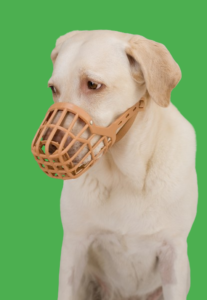Taking a muzzled dog for a walk brings its own unique challenges and, as professional dog walkers, we need to think about some extra aspects of our walk, depending on the reason the dog is muzzled. Let’s take a look at some key aspects dog walkers should remember when they’re out and about with a muzzled dog.
Table of Contents
Reasons to muzzle a dog
Muzzling a dog can be a responsible and necessary measure in certain situations to ensure the safety of the dog, other animals, and people. In the UK, muzzling in public (including vehicles) is a specific condition of owning a breed that requires a certificate of exemption to own.
- Legal requirements:
- In some regions, specific breeds or individual dogs may be required by law to wear a muzzle in public places. This is often a safety measure aimed at preventing potential incidents and ensuring public safety.
- Aggression towards people or other animals:
- A muzzle can prevent a dog from biting or injuring others while allowing the owner to safely manage the dog in public spaces. It provides a physical barrier, reducing the risk of harm. Sighthounds are especially prone to chasing and don’t always recognise the difference between a fleeing rabbit and a cat.
- Fear or anxiety in unfamiliar situations:
- Some dogs may become anxious or fearful in new environments, leading to unpredictable behavior. A muzzle can offer a sense of security, preventing potential incidents when the dog is stressed.
- Medical treatment or grooming:
- During veterinary examinations, grooming sessions, or other medical procedures, a muzzle can protect both the dog and the handler. It ensures that the dog doesn’t inadvertently bite due to fear or discomfort.
- Preventing scavenging or eating harmful substances:
- In outdoor environments, a muzzle can prevent a dog from scavenging or ingesting harmful substances. This is especially crucial in areas where there may be toxins, sharp objects, or potential hazards.
- Preventing excessive chewing:
- Muzzles designed to allow panting and drinking can be used to prevent destructive chewing. This is useful in situations where these behaviors may be disruptive or destructive.
- Rehabilitation and training:
- Muzzles can be used as part of a behavior modification program. They allow trainers and behaviorists to work with dogs on issues like aggression, fear, or anxiety in a controlled and safe manner.
- Transportation safety:
- During travel, especially in crowded or unfamiliar environments, muzzling can prevent a dog from reacting aggressively or unpredictably. It adds an extra layer of safety for both the dog and those around them.
It’s important to note that while muzzles can be a valuable tool, they are not a substitute for addressing the underlying behavioral issues through training.

Considerations when walking a muzzled dog
The public
Muzzled dogs act like magnets in a public setting. Some people just can’t help themselves coming over to reassure you that they’re great with dogs and proceed to stroke your dog. But magnets also repel and you’ll spot people ushering their dogs/toddlers away from you faster than you can say ‘baskerville’.
Acting as an advocate for the dog you’re walking is essential. Sometimes this will mean asking people to walk away, or leave your dog alone. There are some things you can do to help;
- Communication: Clearly communicate to the public that the dog is wearing a muzzle and should not be approached by adding a yellow jacket, lead or lead sleeve that says ‘nervous’ or ‘do not pet’.
- Maintain Distance: Give people ample space when passing by, and be mindful of the dog’s reaction to strangers.
Other dogs
Dogs are often perplexed by items they haven’t seen before, so encountering a muzzled dog in the park might not be something they’ve seen before and they’ll act nervously or differently around your muzzled dog. So be mindful of this when off lead dogs approach you, or when loading your muzzled dog into your vehicle with other dogs.
- Avoid Close Encounters: Steer clear of off-leash dog areas or places with a high concentration of dogs. Ensure a safe distance from other dogs to prevent potential confrontations or stress for the muzzled dog.
- Monitor Body Language: Pay close attention to the muzzled dog’s body language when encountering other dogs. If signs of discomfort or stress are evident, take steps to increase distance or choose an alternate route.
Location
- Choose Quiet Routes: Opt for less crowded dog walking routes to minimize potential stress for the muzzled dog. Avoid busy streets or areas with loud noises that might make the dog anxious.
- Familiarize with the Environment: Be aware of the surroundings and potential triggers for the dog. Familiarize yourself with escape routes or safe spaces in case unexpected situations arise.
- Follow Local Regulations: Adhere to any local regulations regarding muzzled dogs in public spaces. Some areas may have specific rules or restrictions that need to be followed for the safety of everyone.
Transportation
As a dog walker, I would always choose to keep the muzzle on the dog for transportation. Any muzzle that is designed to be worn on a walk will be suitable for transportation too and they should be able to drink water through it in transit.
If you have an accident and the dogs escape their crates, at least the dog will be muzzled and safer to catch.
Make sure they’re able to drink, and check the muzzle can’t accidentally get caught on any crate bars.
Solo walk or group walk for muzzled dogs?
This decision would depend on the reason for being muzzled. Clearly a scavenger muzzled to stop them eating random stuff could be walked in a group, but a fear reactive dog could not. A dog reactive/aggressive to strangers/bicycles/cars etc. could be taken out in a group but it may be wise to keep the group small in order to manage any incidents. Popping three dogs on leads is a lot faster than rounding up 6 dogs to manage the situation.
Group Walk with a Muzzled Dog:
Pros:
- Socialisation Opportunities: Group walks can provide opportunities for muzzled dogs to interact with other dogs, promoting socialisation in a controlled environment.
- Diverse Environments: Exposure to various dogs and surroundings can help desensitise the muzzled dog to different stimuli, contributing to behavioural improvement.
- Professional Supervision: With a professional dog walker, there’s an experienced eye to monitor interactions and ensure the safety of all dogs involved.
Cons:
- Potential Stress: Some muzzled dogs may find the presence of multiple dogs stressful, leading to heightened anxiety or reactive behavior.
- Limited Individual Attention: In a group setting, it may be challenging for the dog walker to provide individualised attention to each muzzled dog’s needs.
- Risk of Misunderstanding: Other dog owners in the group may not fully understand the purpose of the muzzle, leading to potential misunderstandings or concerns.
Solo Walk with a Muzzled Dog:
Pros:
- Individualized Attention: The dog walker can focus solely on the muzzled dog, catering to its specific needs and providing a more personalised walking experience.
- Reduced Stress: Without the presence of other dogs, a solo walk can minimise stressors for the muzzled dog, allowing for a more relaxed and controlled environment.
- Tailored Route: The walker has the flexibility to choose routes that best suit the muzzled dog’s comfort level and avoid potential triggers.
Cons:
- Limited Socialisation: Solo walks may not offer the same level of socialization opportunities compared to group walks, potentially impacting the dog’s overall social skills.
- Missed Training Opportunities: Interactions with other dogs can be valuable training opportunities, and a solo walk may miss out on these chances for positive reinforcement.
- Dependency on Walker’s Expertise: The success of the walk heavily relies on the dog walker’s ability to manage the muzzled dog effectively, as there may be fewer safety nets in place.
Preference Opinion: While both options have their merits, a solo walk seems preferable when dealing with a muzzled dog. The ability to provide undivided attention, tailor the environment to the dog’s needs, and minimise potential stressors outweigh the advantages of group walks. This approach allows for a more focused and controlled experience, supporting the dog’s well-being and training goals.

( https://www.sciencedirect.com/science/article/abs/pii/S016815911300292X )
AFFILIATE DISCLAIMER
The dog walking coach website is supported by our visitors. Some of the product links on this website are through affiliate schemes such as Amazon. This means that I earn a small commission if you choose to purchase something at no extra cost to yourself.

